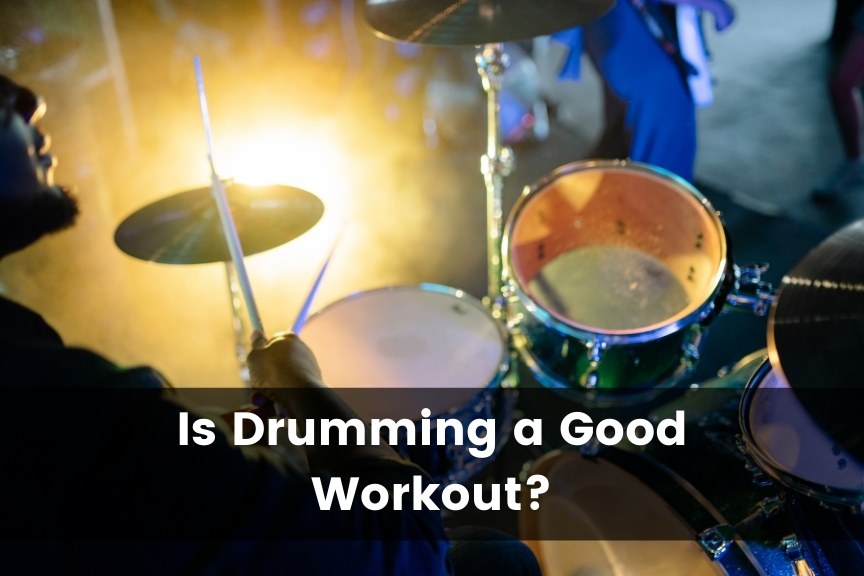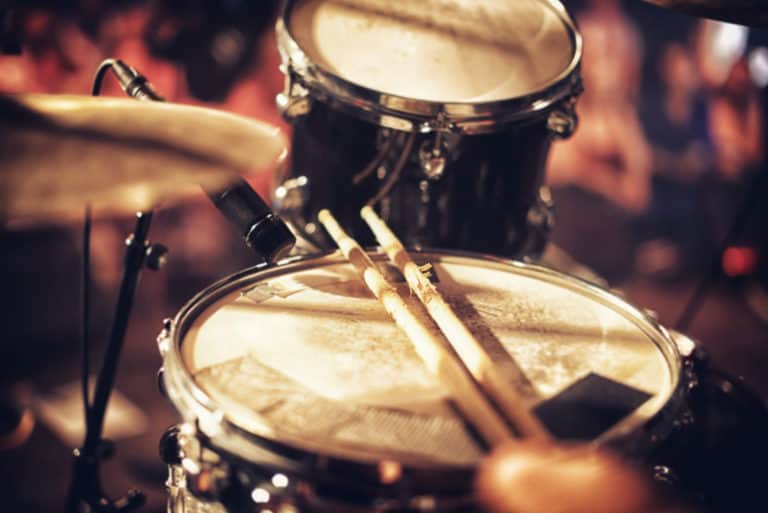Is Drumming a Good Workout?: Calories Burned Drumming
Some people love to exercise enough to pay for a gym membership and schedule time for their daily workout. Others, however, prefer their exercise to come as a byproduct of a fun activity, such as rock climbing, mountain biking, or playing the drums.
Drumming can be a great workout and, depending on how you play and how long you play at one sitting, can burn hundreds of calories. Playing a drum set requires using all four limbs simultaneously and also demands a good deal of core engagement. This combination can make for a solid workout.
Whether you’re already a drummer and curious about how your playing affects your health or you’re thinking about taking up the drum set as opposed to a weight set, drumming can work as a form of exercise provided you play long and hard enough. Let’s look at why it’s a good workout option and how many calories you can expect to burn.
Is Drumming Good Exercise?
We exercise to stay healthy, keep our bodies in good shape, and ensure our hearts work as well as possible. Despite what so-called miracle cures promise, to be healthy, we have to:
- Control calorie intake.
- Make sure those calories are from beneficial sources (not junk food).
- Exercise.
When it comes to weight loss, there is only one option: burning more calories than you eat. This is done by exercising more or cutting down on how much you eat. To speed up weight loss, doing both – controlling food intake and working out more (or more effectively) – is usually the recommended course of action.
Clem Burke is a founding member of Blondie and a shin-kicking drummer. Alongside British researchers, he participated in a study of the energy expenditure involved in playing the drums over the course of ten years.
In an 80-minute concert, Burke maintained, according to the data, a heart rate of around 145 beats per minute. According to his age and the target heart rates needed to provide cardiovascular benefits, this was a terrific exercise session for Burke.
Drumming is good exercise, as demonstrated by the study mentioned above. Additionally, the data remained consistent for the ten years of the study, which shows that drumming offers long-term benefits.
Playing Style Affects Calories Burned
It should be noted that the number of calories you burn will be affected by the way you play – if you’re a calm drummer who doesn’t move around much more than required, you’ll likely burn fewer calories than someone who is more active.
This can be seen with a few well-known drummers, including Burke.
This video of a live performance of “Heart of Glass” shows that Burke is obviously exerting himself, playing hard, fast, and loud, and throwing in some showy elements that use large arm movements:
These movements require more muscle power, burn more calories, and raise the heart rate.
The Rolling Stones’ late drummer Charlie Watts had a reputation for understated playing. He often sat behind the set, nearly stock-still, with an enigmatic grin on his face as he laid down a groove. Many people assume he wasn’t doing much.
But, as seen in this video of him playing “Jumpin’ Jack Flash,” you can see that even though he’s not wildly swinging his arms and bouncing nearly off the drum throne, he’s not exactly a lump on a log.
This video makes it pretty clear that the man is burning calories, which shows that even understated drumming is enough to give you a good workout.
Dave Grohl, who played drums for Nirvana and now fronts Foo Fighter, is on the other end of the spectrum. He has a reputation that might be considered the polar opposite of Watts’ because he plays big, loud, fast, and seems to hold back nothing. This video of him playing “Smells Like Teen Spirit” might actually wear you out, even if you’re not the one playing:
How Many Calories Do You Burn Playing Drums?
You burn a lot of calories playing drums, especially when compared to playing other instruments. Exactly how many will hinge on how long you play, your weight, how intensely you play, and other such factors.
Playing a straight, four-on-the-floor pattern at low volume for an hour will burn fewer calories than an hour of loud, fast, complicated fills will. Additionally, if you’ve got a four-piece drum set, you’ll use less effort getting to your individual drums than will someone playing a more extensive kit that will involve reaching out for or leaning toward some of the drums on the set.
Calculating Calorie Burn
Exercise scientists use a metabolic equivalent (MET) to determine how many calories a person burns during various activities. A MET of one is the measurement of how many calories a person burns while sitting still and not taking in more calories (so “not eating”). Adding physical activity raises the MET.
We calculate how many calories we burn with this formula:
- Call the minutes of physical activity “M.”
- Determine the MET of the activity, and call that number “MET.”
- Find your weight in kilograms by dividing your weight in pounds by 2.2.
- Call your weight in kilograms “W.”
- Assemble the figures in this formula: M × (MET × 3.5 × W) / 200.
- The resulting figure is the number of calories burned.
Playing drums has an approximate MET of 3.8, so with a 180 lb. (81 kg) man, we can calculate:
- 30 minutes of playing drums x (3.8 MET for playing drums x 3.5 x 81 kg) / 200 = 161.6 calories burned.
- 60 minutes of playing drums x (3.8 MET for playing drums x 3.5 x 81 kg) / 200 = 323 calories burned.
- 120 minutes of playing drums x (3.8 MET for playing drums x 3.5 x 81 kg) / 200 = 646.3 calories burned.
Let’s compare those figures to the numbers that you can expect if the same man goes road biking at about 12 mph (19 kph):
- 30 minutes of biking x (8 MET x 3.5 x 81 kg) / 200 = 340.2 calories (1423 kJ) burned.
- 60 minutes of biking x (8 MET x 3.5 x 81 kg) / 200 = 680.4 calories (2847 kJ) burned.
- 120 minutes of biking x (8 MET x 3.5 x 81 kg) / 200 = 1360.8 calories (5694 kJ) burned.
It’s probably not a surprise that some activities burn more calories than playing drums – after all, there is a reason why people suggest biking over drumming when it comes to weight-loss advice.
However, while drumming may not be the most physically demanding activity, it’s undeniable that it does burn calories and should be enough for a daily workout for weight loss.
You can find a pretty comprehensive list of the METs of various activities here. And let’s look at an hour of drumming versus an hour of other activities. Again, we’ll deal with a 180 lb. (81 kg) man performing 60 minutes of various exercises and undertakings.
| Activity | MET | Calories burned |
| Running stairs | 15 | 1275.8 (5338 kJ) |
| Jumping rope | 12.3 | 1046.1 (4377 kJ) |
| Snow shoveling | 8.8 | 748.4 (3131 kJ) |
| Firefighting | 8.0 | 680.4 (2847 kJ) |
| Playing basketball | 8.0 | 680.4 (2847 kJ) |
| Playing football | 8.0 | 680.4 (2847 kJ) |
| Playing ultimate frisbee | 8.0 | 680.4 (2847 kJ) |
| Playing tennis | 7.3 | 620.9 (2598 kJ) |
| Playing soccer | 7.0 | 595.4 (2491 kJ) |
| Swimming | 6.0 | 510.3 (2135 kJ) |
| Indoor rock climbing | 5.8 | 493.3 (2064 kJ) |
| Lawn mowing | 5.5 | 467.8 (1957 kJ) |
| Playing in a marching band | 5.5 | 467.8 (1957 kJ) |
| Hiking | 5.3 | 450.8 (1886 kJ) |
| Elliptical trainer | 5.0 | 425.3 (1779 kJ) |
| Dance class | 5.0 | 425.3 (1779 kJ) |
| Skateboarding | 5.0 | 425.3 (1779 kJ) |
| Kayaking | 5.0 | 425.3 (1779 kJ) |
| Ashtanga yoga | 4.0 | 340.2 (1423 kJ) |
| Raking leaves | 3.8 | 323.2 (1352 kJ) |
| Bird hunting | 3.3 | 280.7 (1174 kJ) |
| House cleaning | 3.3 | 280.7 (1174 kJ) |
| Pilates | 3.0 | 255.2 (1068 kJ) |
| General carpentry | 3.0 | 255.2 (1068 kJ) |
| Surfing | 3.0 | 255.2 (1068 kJ) |
| Hatha yoga | 2.5 | 212.6 (890 kJ) |
| Orchestral conducting | 2.3 | 195.6 (818 kJ) |
| Delivering US mail on foot | 2.3 | 195.6 (818 kJ) |
| Cooking | 2.0 | 170.1 (712 kJ) |
| Sleeping | 0.95 | 80.8 (338 kJ) |
Drumming for Weight Loss
If you’re looking to lose weight, you have to exercise. Again, the only way to lose weight is to burn more calories than you eat. Also, in review, playing the drums for an hour is more enjoyable than jogging around a track in the heat while younger, faster runners pass you and make you feel old.
So can drumming melt the pounds off? Yes, it can, provided you do it consistently and don’t eat way more calories than usual. Making changes to diet is arguably just as important as burning calories.
The general rule is that an American male needs about 2,500 calories (10,460 kJ) per day and a woman 2,000 (8,368 kJ) to maintain body weight. That means our 180-lb. (81 kg) man we’ve been using in our example burns about 2,500 calories (10,460 kJ) each day without exercising. He will need to burn more than that to lose weight, and he can augment that weight loss by taking in fewer than 2,500 calories (10,460 kJ).
If he plays the drums for one hour, he’ll burn 373 calories (1,561 kJ). To lose one pound, a person must burn about 3,500 more calories (14,644 kJ) than they eat. Looking at a weekly diet and exercise plan, this translates to burning 500 more calories (2,092 kJ) per day than you eat.
So our 180-lb. (81 kg) man, eating 2,500 calories (10,460 kJ) per day and playing drums for one hour five times each week takes in 17,500 calories (73,220 kJ) each week and burns 19,365 (81023 kJ) — a caloric deficit of 1,865 (7803 kJ). This translates into losing about half a pound (about .23 kg) each week.
If he cuts his caloric intake by 500 (2,092 kJ) each day in addition to the drumming, he’ll burn more than 5,000 calories (20,920 kJ) than he eats and will lose nearly a pound and a half (.68 kg) each week, just from playing the drums.
It should be noted that you should not lower your caloric intake below the recommended minimum (2,500 for men and 2,000 for women) unless approved by a healthcare professional. Additionally, drumming is unlikely to be enough of a workout if you want to lose a lot of weight fast. In such a situation, you’ll need to look at another activity, and may also need to speak to a nutritionist for further help.
Is Drumming Good Cardio?
When you consider everything that playing the drums involves, it is easy to see that the heart rate increases nearly instantly when you start playing.
Drumming is excellent cardio because it requires the drummer to engage multiple muscle groups at once. Additionally, it requires high intensity engagement of these musceles for extended periods.
In fact, it is such good cardio that it has actually spawned an exercise craze known, appropriately, as cardio drumming. You won’t get hired to play with your local cover band by advertising that you’re a cardio drummer, but if you get in on the craze, you’ll at least be in shape.
Cardio Drumming
Instead of drums, the exercise regimen uses an exercise ball and drumsticks. Players keep their backs straight while slightly leaning over the ball, so their cores engage. There aren’t any rudiments involved, and you probably won’t hone your five-stroke roll skills, but you’ll work up a sweat.
While it might be good exercise, doing cardio drumming won’t make you a drummer anymore than riding a Peloton makes you a cyclist, or doing aerobics makes you a dancer.
Cardiac Activity While Drumming
Drummers have been called world-class athletes because of everything discussed above regarding the physical effect that playing has on their bodies. When you play the drums, you have to have both stamina and the coordination needed to make each of your four limbs do something different for extended periods.
We know that working the larger muscles in our legs raises the heart rate faster and higher than working the relatively smaller muscle groups in our arms. Playing a drum set means working both sets of limbs, which, of course, means a rising heart rate.
When discussing cardio, we often hear of the target heart rate, determined by age. To reap cardio benefits, people need to reach their target heart rate during exercise and hold it there. Going back to the study involving Clem Burke, we can see that his heart rate, as monitored during one concert, was at or above his target heart rate for nearly the entire concert.
That’s an indication of a good, solid cardio workout. There is no reason that any drummer cannot achieve similar results, and they don’t have to be professional players to do so.
The Department of Health and Human Services recommends 150 minutes of cardio each week to maintain good cardiovascular health. Reaching your target heart rate by playing the drums for two and a half hours per week meets this goal. Our 180-lb. (81 kg) drummer, who plays for an hour a day, five days a week, should enjoy excellent cardiovascular health.
What Muscles Does Drumming Work?
Playing the drums requires coordination, as we’ve mentioned (and as you might have learned on your own), because the act involves using different muscles at the same time.
Drumming works on a number of different muscles throughout your body, because you’re moving several limbs at one. You’re working everything from your glutes, triceps and biceps, flexors, and more.
To understand why this is the case, consider what happens when you do a bench press. During this type of excerise, you work lots of muscles at once, including your:
- Pectorals
- Deltoids
- Triceps
- Biceps (to a lesser extent)
- Trapezius
- Your core
But when you play the drums, you’re doing that sort of thing all over your body. So let’s break it down.
Most drummers use the same layout for their drum sets, so we’ll presume that the right foot plays the bass drum, the left controls the hi-hat pedal, the right arm keeps time on the hi-hat or ride, and the left arm covers the backbeat on the snare drum. Both arms are equally involved in playing fills.
- Right leg. Muscles raise and lower the foot in pressing the bass drum pedal, including the glutes, quadriceps, flexor and extensor muscles, and adductors. The quads alone are huge muscles, so engaging just those burns calories and raises your heart rate.
- Left leg. You use the same muscles as the right because you’re working a pedal just like the right, but you may use your left leg muscles a bit less, depending on how you play.
- Right arm. This limb probably does the most work since the hi-hat gets played fairly constantly throughout a song. Traps, delts, biceps, triceps, flexors, and extensors all get used here, and anyone who’s felt that burn in their forearm after playing a really fast piece knows it.
- Left arm. As with the legs, the same left arm muscles get worked as the right, with a little less frequency. While the right arm produces sounds on the hi-hat usually eight times per measure, the left arm often just makes two sounds per measure for the bulk of a song.
- The rest of the body. Your arms and legs need support, so while sitting at the set, moving around, playing, and guiding your limbs through their tasks, you’ll find that your obliques and abdominal muscles get a lot of use. You’ll also work the muscles in your hands and fingers.
It takes, it’s fair to say, most of your muscles to make the drum set work right. It’s a full-body workout, so the next time you see a drummer without a shirt, realize that it’s probably because he’s sweating and not because he’s an exhibitionist.
Conclusion
Playing the drums can be fun, it can be a job, and it can also be a way to reach weight loss and exercise goals. When a drummer sits down to practice or perform, she engages a vast number of muscles, and the intensity of her playing raises her heart rate and burns calories.
Since we know that elevating our heart rates is key to cardiovascular health and that we need physical activity to burn calories (to either lose weight or keep weight off), regular drumming has proven itself a viable option for an exercise routine.







